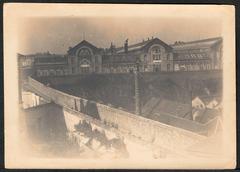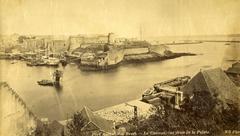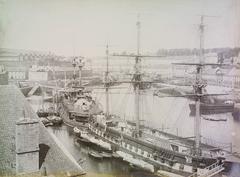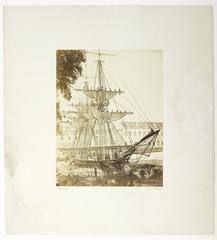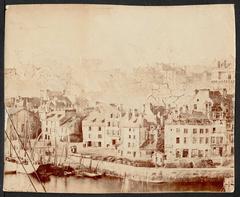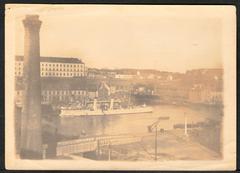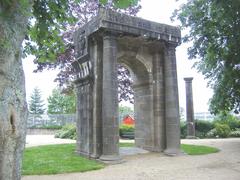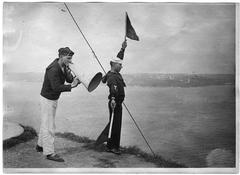
Brest Naval Training Centre: Visiting Hours, Tickets, and Historical Sites in Brest, France
Date: 04/07/2025
Introduction
Located in the historic port city of Brest, France, the Brest Naval Training Centre (Centre d’Instruction Naval de Brest, CIN) is a foundational institution in French naval tradition and maritime defense. As a key training hub for naval officers and specialists, the Centre not only shapes future generations of naval personnel but also stands as a testament to Brest’s enduring maritime legacy, stretching from the Middle Ages to the present. Although the Centre is primarily an active military facility with restricted public access, special open days and guided tours provide rare opportunities for visitors to engage with France’s naval heritage. This comprehensive guide offers detailed insights into the Centre’s history, visiting protocols, ticketing, accessibility, nearby attractions, and essential travel tips to ensure an informed and rewarding visit to Brest’s maritime heart.
For the latest information, consult official resources such as the French Navy Official Site and the Brest Tourism Office.
Table of Contents
- Introduction
- Historical Background and Evolution of the Brest Naval Training Centre
- Visiting the Brest Naval Training Centre: Practical Information
- Frequently Asked Questions (FAQ)
- Cultural and Strategic Significance
- Visuals and Media
- Conclusion and Call to Action
- References
Historical Background and Evolution of the Brest Naval Training Centre
Medieval and Early Modern Naval Foundations
Brest’s maritime significance can be traced to the Middle Ages, becoming a focal point of regional power and naval conflict. In the 13th and 14th centuries, control of Brest was central to the authority of the Dukes of Brittany. The city’s integration into France in the early 16th century set the stage for its transformation into a strategic port. Cardinal Richelieu began systematic harbor development in 1631, followed by Jean-Baptiste Colbert’s enhancements and Vauban’s formidable fortifications, establishing Brest as a major naval base (Brest Historical Overview).
Brest as a Naval Powerhouse: 17th–19th Centuries
The 17th and 18th centuries saw Brest emerge as the cornerstone of French naval defense and colonial expansion. The city’s robust fortifications enabled it to withstand attacks such as the failed English assault in 1694. By the 19th century, Brest’s shipyards and training facilities were producing generations of sailors and officers, cemented by the founding of the École des Mousses in 1834, which formalized naval training for young recruits (The Mousses School).
20th Century: Wars, Destruction, and Rebirth
Brest played a pivotal role in both World Wars, serving as a major disembarkation point and later as a German U-boat base during World War II. The 1944 Battle for Brest resulted in near-total destruction of the city, but post-war reconstruction restored its naval facilities. The 1972 establishment of the nuclear submarine base at Île Longue further reinforced Brest’s strategic importance (Brest Historical Overview).
The Modern Brest Naval Training Centre: Structure and Evolution
École de Maistrance and École des Mousses
The Centre encompasses key naval schools, notably the École de Maistrance (established in 1988) for non-commissioned officers, and the École des Mousses (originally founded in 1834, re-established in 2009) for young volunteers aged 16–17. These institutions deliver rigorous military, academic, and technical training, preparing recruits for operational assignments within the French Navy (Military School Directory; The Mousses School).
Training Philosophy and Curriculum
Training blends military discipline with academic instruction and hands-on seamanship. Students may specialize in fields such as mechanics, operations, or combat, with advanced certification options like the Brevet d’Aptitude Technique de Spécialité (BAT) for those aspiring to join the officer corps.
Integration with Operational Naval Activities
Close integration with the operational fleet is a hallmark of the Centre. Trainees participate in onboard experiences, naval exercises, and real-world operations. Located adjacent to the main naval base and the Île Longue submarine base, the Centre provides unique exposure to cutting-edge naval technology and international cooperation, as exemplified by the 2024 U.S. Navy VLS rearming operation in Brest (Naval News).
Visiting the Brest Naval Training Centre: Practical Information
Visiting Hours and Tickets
- General Access: The Brest Naval Training Centre is an active military installation, generally closed to the public except during special open days or pre-arranged guided tours. Updates are posted on the French Navy Official Site and the Brest Tourism Office.
- Open Days & Special Events: Access is possible during events such as the International Maritime Festival and Heritage Days (Journées du Patrimoine). Tours are limited and require advance booking.
Tickets and Booking
- Tickets: When available, tickets for tours and special events can be reserved through the Brest tourism office or official Navy channels. Booking in advance is strongly recommended (SkyTicket).
- Pricing: Most public events or tours are either free or require a nominal fee.
Security and Visitor Requirements
- Identification: Valid government-issued ID (passport or EU ID card) is mandatory.
- Security Screening: All visitors must undergo security checks. Photography is restricted to designated areas.
- Accessibility: The Centre and nearby museums offer accommodations for visitors with disabilities; confirm specific requirements with the tourism office (Brest Métropole Tourisme).
Travel Tips
- Getting There: Brest is accessible by TGV (approx. 3.5 hours from Paris), by car, by air via Brest Bretagne Airport, and by regional bus services (France Guide: How to get to Brest).
- Local Transport: Public buses and trams connect the city center with the port and naval sites.
Nearby Attractions and Recommended Itineraries
While direct access to the training centre is limited, Brest offers a wealth of maritime and historical attractions:
- National Maritime Museum (Musée National de la Marine): Located in the Château de Brest, this museum features extensive displays on naval history, ship models, and maritime technology (France Guide: National Maritime Museum).
- Tour de la Motte-Tanguy: A medieval tower with panoramic views and historical exhibits (France Guide: Tour de la Motte-Tanguy).
- Océanopolis: A renowned ocean park and marine research center (France Guide: Oceanopolis).
- Cours Dajot: A scenic promenade overlooking the port and naval base.
- Capucins Workshops (Les Ateliers des Capucins): Historic naval workshops now serving as a vibrant cultural hub (France Guide: Les Ateliers des Capucins).
Combine museum visits with harbor tours and walking explorations of Brest’s maritime district for a comprehensive itinerary.
Special Events and Guided Tours
- International Maritime Festival: Held every four years, this event features historic ships, naval demonstrations, and cultural activities, often including rare access to the naval base (France Voyage).
- Heritage Days (Journées du Patrimoine): Annual open days with special tours of historic and operational sites.
- Educational Visits: Group tours and educational programs can be arranged through official channels with advance notice (Brest Tourism Office).
Frequently Asked Questions (FAQ)
Q: Can I visit the Brest Naval Training Centre at any time?
A: No, public access is only possible during special open days or by joining pre-arranged guided tours.
Q: How do I book tickets for a tour?
A: Tickets must be booked in advance through the Brest Tourism Office or official navy channels, especially during major events (SkyTicket).
Q: What identification is required?
A: A valid government-issued ID (passport or EU national ID card) is required for all visitors.
Q: Is the Centre accessible for visitors with disabilities?
A: Yes, but it is best to confirm specific needs with the tourism office.
Q: Are there other sites to visit if the Centre is closed?
A: Yes, visitors can explore the National Maritime Museum, Tour de la Motte-Tanguy, Océanopolis, and the Capucins Workshops.
Q: Are there guided tours in English?
A: Some tours and museum programs are available in English; inquire in advance.
Cultural and Strategic Significance
The Brest Naval Training Centre embodies Brest’s enduring maritime spirit and pivotal role in French naval history. Its evolution from a medieval stronghold to a modern center of naval excellence highlights the city’s adaptability and resilience. The Centre’s integration with operational naval activities and international cooperation, notably with NATO allies, underscores its ongoing strategic importance (Naval News).
Urban renewal projects, such as the transformation of the Capucins Workshops, reflect Brest’s commitment to balancing heritage preservation with innovation, ensuring that the city remains a vibrant maritime capital (France Guide: Les Ateliers des Capucins).
Visuals and Media
For an enhanced experience, visitors are encouraged to explore:
- Virtual tours and photo galleries on the Brest Tourism Office website and French Navy Official Site.
- High-quality images of the Brest Naval Training Centre, maritime parades, and historic sites.
- Alt tags such as “Brest Naval Training Centre campus aerial view” and “National Maritime Museum Brest tickets” for accessibility and SEO.
Conclusion and Call to Action
The Brest Naval Training Centre offers a unique gateway into France’s naval heritage. While general public access is restricted, informed planning and participation in special events allow visitors to experience the depth of Brest’s maritime tradition. Combine your visit with explorations of nearby museums and historical sites for a comprehensive understanding of the city’s naval legacy.
For the latest updates, event announcements, and visitor resources, download the Audiala mobile app, follow official social media channels, and consult the recommended websites below.
References
- Brest Historical Overview
- The Mousses School Trains the Future Sailors of the French Navy
- Military School Directory - France École de Maistrance
- Naval News: U.S. Navy Demonstrates VLS Rearming at French Naval Base
- French Navy Official Site
- Brest Tourism Office
- Military School Directory - Brest Naval Training Centre
- France Guide: Brest and Maritime Heritage
- Wikipedia: Brest, France
- FranceRent: Brest Destination Guide
- Brest Métropole Tourisme
- SkyTicket: Brest Naval Training Centre Tours
- France Voyage: Brest International Maritime Festival
- The Crazy Tourist: Best Things in Brest








